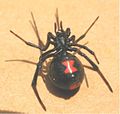Black Widow Spiders
Common name:

Female black widow showing red "hourglass" marker.
Scientific name: Order Araneae, family Theridiidae, Latrodectus mactans
Size: Adult--9/16" to 1 1/2"
Identification: Adult females have shiny black bodies and a distinctive red hourglass-shaped marking on the underside of the abdomen. The compact webs are off-white and dense. Males are smaller and have markings on the upper side of the abdomen and large eyes.
Biology and life cycle:
Habitat:
Feeding habits: Mostly very small insects.
Economic importance: Bites can be very dangerous, especially to children and debilitated people.
Natural control: Mud daubers and predatory insects.
Organic control: Physical removal of webs. Outdoor toilets are the most common place where people are bitten. Spray plant oil products or dust with natural diatomaceous earth.
Insight: Bites cause little or only momentary pain, but the poison causes severe cramping and aching pain from ten to sixty minutes after the bite. The pain spreads to all the skeletal muscles of the body and causes severe hardening of the abdomen. Most deaths are children and the sick and debilitated. Seek prompt medical attention.
Q: I have killed almost a hundred Wolf Spiders in our house and garage; I have killed a few African Jumping spiders in my house, and had a Brown Recluse alive in our bath room. But now I am concerned, because tonight I had a female Black Widow in the middle of her web under my back patio door. When I spray the spider with Spider Shot spray it does nothing, but wasp spray does kill them after I drench them. I am getting really concerned, because I have a three week old baby and a house full of spiders. What can I do to rid our house of the pests? I know they are suppose to be good for insect control, but considering a Black Widow has venom 15 times as potent as a Rattle Snake, I prefer not to have these spiders in or around my house. Insecticide is just not doing the trick. J.R., McKinney.
A: The sprays you are using are far more dangerous to your child than the spiders. Although most of the spiders are non- poisonous, the orange oil sprays will kill them. Stomping on the individual ones works well. There's also good information in the Texas Bug Book. Wolf spiders and jumping spiders for example are non-aggressive, safe and very beneficial in helping to control pests.
For more information see the Texas Bug Book.
|
|
Search Library Topics Search Newspaper Columns




